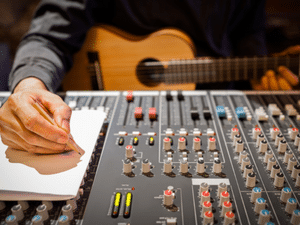Songwriting: 5 Elements of a Memorable Song
By: WhisperRoom™
February 9, 2022


Everyone is familiar with the feeling of having certain songs stuck in their heads. Furthermore, these motives invade thoughts, repeating themselves over and over. As a result, such songs quickly become hits and win numerous awards. Do you know how to write a memorable song?
One can often hear that composing music and songs is easy and anyone can do it. Of course, anyone can do it, but not everyone can write memorable songs. Everyone has had the experience of hearing a song only once and having it stuck in their head for the rest of the day.
Scientists often refer to such hits as “earworm songs.” Numerous elements in their structure contribute to them being a memorable hit. So, how does this magic work?
There is no single hit formula. You cannot string together a few good lines and expect them to become a memorable motive. However, there are five elements that are common to all hit songs. Let’s find out what they are.
In addition to the lyrics, a hit song usually has a melody that is easy to remember. If you hear it once, you will be able to repeat it again over time.
To see if your song’s melody is memorable, sing/play it to your friends. Will they be able to repeat it right away? If that is the case, other listeners will likely be able to remember it as well.
The name of a song is yet another mechanism for remembering it. It should be a “trigger” for the listeners’ brains – easy to remember and recall as soon as they see or hear the word or phrase somewhere.
For example, George Michael’s song “Faith”. It is a very common word, so it is often used in different places. Furthermore, many brands use it to name their new perfume or shoe line. So, while trying on a new pair of shoes, the client can unobtrusively recall a song they heard many years ago in a taxi.
People who listen to music want it to be clear and memorable, but they also want something unique. Each genre usually has its distinct vocabulary. On the other hand, the presence of two or more genres in the song at the same time is a factor ensuring a higher ranking. In other words, songs that go beyond the genre go beyond ordinary patterns, and in most cases, are more likely to succeed. If you are having trouble formatting your lyrics properly or require assistance, go to an essay writing service such as Trust My Paper.
The first line in the lyrics is important because it introduces the subject the song is dedicated to, sets the mood for the entire hit, and helps draw listeners’ attention from the very beginning. The first line should pique the listener’s interest and entice them to hear how the story unfolds throughout the song.
Then, create a strong lyrical “hook”. Musicians frequently emphasize its importance in capturing the attention of the audience. In a particular section of the song, the hook is a magical combination of text, melody, and rhythm.
From the standpoint of lyrics, it is a memorable phrase repeated throughout the song. It is frequently (but not always) found in the chorus section.
To find a “hook” for your song, listen to catchy phrases that appear in everyday life or popular culture. Look for inspiration in books, films, and popular TV shows. Remember that although the hook is only a five-second segment, it can be enough to get your song stuck in people’s heads.
Writing lyrics for a song is similar to writing an essay or conducting research. Before you get a good piece of writing, you must make dozens of corrections to make it look professional and relevant to the subject. If you require writing assistance, go to an essay writing service like SupremeDissertations to find the help you need.
While composing the song, write more than you need and choose the best. After you have a chorus or chorus and a couple of verses, you have an almost finished first draft of your song.
However, it would be nice to keep writing to see if you can come up with something better than what you have. You can then edit the lyrics by selecting the best lines for your song.
The quality of your song is crucial. It must not only be well-written but also well-executed. Invest in the necessary equipment and technical capabilities. If necessary, contact the recording studio’s professionals. The majority of the music heard on the radio is produced using digital audio system software (for example, Ableton and Pro Tools). It enables musicians to produce high-quality songs without the need to visit a professional studio.
Frank Hamilton is a blogger and translator from Manchester. He is a professional writing expert in such topics as blogging, digital marketing, and self-education. He also loves traveling and speaks Spanish, French, German, and English.
